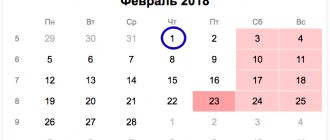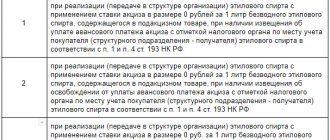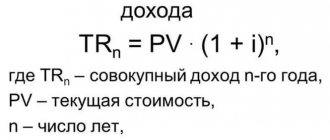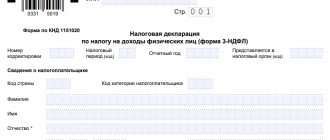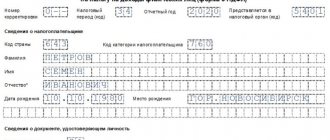Deadlines for submitting VAT returns
The VAT declaration is submitted to the Federal Tax Service quarterly in electronic form, no later than the 25th day of the month following the expired quarter (clause 5 of Article 174 of the Tax Code of the Russian Federation). In 2021, the declaration must be submitted within the following deadlines:
- for the fourth quarter of 2021 - no later than 01/27/2021;
- for the first quarter of 2021 - no later than 04/26/2021;
- for the second quarter of 2021 - no later than July 26, 2021;
- for the third quarter of 2021 - no later than November 25, 2021;
- for the fourth quarter of 2021 - no later than 01/25/2022.
Line by line instructions
Let's show with an example how to fill out section 9.
PJSC TechnoKvant produces industrial air fresheners and sells them independently. On January 9, the company shipped products worth RUB 28,974,230.94 to a wholesale customer. (including VAT (20%) = 4,829,038.49 rubles) - invoice No. 3 dated 01/09/20XX. There were no other shipments in the 1st quarter.
PJSC TechnoKvant prepares a VAT return using the following approaches:
- The initial data is entered into the declaration from the accounting program.
- The declaration is generated and submitted to controllers in electronic form.
- The correctness of the information included in the declaration is checked by internal control specialists of PJSC TechnoKvant.
Let's see step by step how TechnoKvant PJSC will fill out section 9 of the VAT return for the 1st quarter.
Lines 001–030
Lines 035–100
In this block, PJSC TechnoKvant will fill out only line 100 “TIN/KPP of the buyer”. There is no data for the remaining lines:
Lines 110–220
On this page of section 9 PJSC TechnoKvant will fill in 3 lines:
- 160 “Cost of sales according to invoice... (including tax)”;
- 170 “Cost of sales subject to tax...(without tax)”;
- 200 “Tax amount...”.
Lines 230–280
PJSC TechnoKvant will fill out the final block of lines in Section 9 as follows:
Procedure for filling out a VAT return
Order of the Federal Tax Service of the Russian Federation dated October 29, 2014 N ММВ-7-3/ [email protected] approved the form of the VAT declaration, the procedure for filling it out and the electronic format for submission. Complete the declaration as follows:
- title page. In the field “at location (accounting) (code)” - 214. And in the field “Tax period (code)” - 23;
- Section 3 contains the calculation of the tax amount for ordinary transactions. It does not need to reflect non-taxable transactions and transactions at a 0% rate;
- You need to transfer data from the purchase and sales books to sections 8 and 9. Attachments to these sections are needed only for updated declarations;
- Section 1 should be completed last. Line 030 is filled in only if the company is exempt from VAT, but has issued an invoice. To line 040 you need to transfer the amount of VAT payable from line 200 of section 3. If VAT is refundable, in line 050 you should indicate the amount from line 210 of section 3, and leave line 040 empty.
Additionally you need to fill out:
- section 2 - if the company pays VAT as a tax agent, for example when leasing state property;
- section 7 - if there were non-taxable transactions in the period.
The remaining sections are intended for specific operations. In particular, section 10 - 11 are handed over by intermediaries - commission agents and agents, and sect. 4 - 6 - exporters.
Please note that by Order of the Federal Tax Service of the Russian Federation dated August 19, 2020 No. ED-7-3 / [email protected] changes were made to the VAT declaration form, the rules for filling it out and the electronic format. The updated form takes into account the latest legislative changes regarding the addition of lists of VAT-free transactions (laws dated 04/15/2019 No. 63-FZ, dated 06/08/2020 No. 172-FZ, dated 07/26/2019 No. 211-FZ, dated 07/31/2020 No. 265 -FZ).
These include:
- free transfer of real estate to the treasury of the Russian Federation, property for the treatment of coronavirus;
- implementation of MSW management services;
- transfer of exclusive rights to domestic computer programs.
Also, the laws of December 25, 2018 No. 493-FZ and of June 6, 2019 No. 123-FZ included the sale of airport services for international flights and flights within the Russian Federation not through Moscow and the region into the list of transactions subject to a zero VAT rate.
The corresponding codes appeared in Appendix No. 1 “Operation Codes”.
The innovations apply to reporting for the fourth quarter of 2020.
Before submitting your VAT return, we recommend that you check its data with the indicators in your income tax return .
The fact is that if there are discrepancies, tax authorities will require clarification. Moreover, the court supports this requirement.
In what cases is it necessary to enter data in section 6
Sections 4, 5 and 6 of the VAT tax return need to be included in the report only if the taxpayer in a given tax period carried out operations related to the export of products, as well as goods, works, and services.
VAT for these transactions is calculated based on a rate of 0%. If within 180 days the exporting taxpayer manages to collect the necessary documents confirming the zero rate, then his responsibility will be to fill out section 4 and submit it as part of the VAT tax reporting.
Read more about this in the article “How to correctly fill out section 4 of the VAT return when applying a 0% rate.”
If the period of 180 days established by law expires, and there are no documents providing grounds for a zero rate, then the taxpayer must fill out Section 6. We will describe the basic rules for filling it out below.
Typical errors in the VAT return that tax authorities identify
As part of control activities, inspectors most often identify the following errors in VAT returns:
1. Incorrect transaction code for the sale of goods (work, services) to VAT payers
In section 9 “Information from the sales book” of the declaration, taxpayers-sellers reflect transactions of the sale of goods (work, services) to buyers - VAT payers, using transaction type code 26 (“Sales of goods (work, services) to persons who are not VAT payers”). Invoices with code 26 do not participate in the process of comparing invoices from section 8 “Information from the purchase book” of the buyer’s declaration and invoices from section 9 of the seller, as a result of which auto claims are generated to taxpayers for identified discrepancies.
2. Errors when deducting VAT in parts
The right to deduction can be used within 3 years from the date of its occurrence, and the amount of tax on the invoice can be declared in installments over several tax periods (letter of the Ministry of Finance of the Russian Federation dated May 18, 2015 No. 03-07-RZ/28263). At the same time, taxpayers, when deducting VAT in parts, incorrectly fill out column 15 of the purchase book (cost of purchases according to the invoice) (line 170 of section 8).
Decree of the Government of the Russian Federation dated December 26, 2011 No. 1137 established that when accepting invoices for deduction in parts, column 16 of the purchase book (VAT amount on the invoice) (line 180 of the section reflects the part of the total tax amount that is accepted for deduction in the current quarter. And in column 15 of the purchase book (line 170 of the section)
reflects the part of the total tax amount that is accepted for deduction in the current quarter. And in column 15 of the purchase book (line 170 of the section) the cost of goods (work, services) is always indicated, indicated in column 9 on the line “Total payable” of the invoice, without dividing into parts.
the cost of goods (work, services) is always indicated, indicated in column 9 on the line “Total payable” of the invoice, without dividing into parts.
In addition, in column 13b of the sales book (invoice value of sales) (line 160 of section 9) and in column 14 of the invoice journal (cost of goods) (line 160 of section 10) it is also necessary to reflect the total cost of sales according to the invoice - invoice without division.
3. Incorrect recording of import transactions
Taxpayers in the purchase book and section 8 of the declaration incorrectly reflect import transactions from EAEU member countries (transaction type code 19) and from other countries (transaction type code 20).
Decree of the Government of the Russian Federation dated December 26, 2011 No. 1137 established that when reflecting in the purchase book a transaction for the import of goods from the EAEU, in column 3 “Number and date of the seller’s invoice” of the purchase book, the registration number of the application for the import of goods from the territories of the EAEU states, assigned tax authority, and the date of registration of the application for the import of goods and payment of indirect taxes.
When reflecting in the purchase book a transaction for the import of goods from other countries not included in the EAEU, in column 3 “Number and date of the seller’s invoice” of the purchase book the number and date of the customs declaration are indicated.
4. Incorrect completion of the title page of the declaration if it is submitted by the legal successor
When submitting a declaration for another organization as a legal successor, in the title page in the column “Code of the place of submission,” code 215 (“At the location of the legal successor who is not the largest taxpayer”) or 216 (“At the place of registration of the legal successor who is the largest taxpayer”) is indicated with indicating the code of the reorganization form, TIN and KPP of the reorganized company in the appropriate columns. If in this situation, on the title page in the column “Code of the place of submission” you indicate code 213 (“At the place of registration as the largest taxpayer”) or 214 (“At the location of the Russian organization that is not the largest taxpayer”), the declaration will be considered submitted for oneself . As a result, the previously submitted form receives the status “irrelevant”.
Thus, as a result of these errors, discrepancies arise, leading to increased paperwork and an undesirable burden on both the taxpayers themselves who committed violations and their counterparties.
Letter from the Federal Tax Service of the Russian Federation for the Moscow Region dated December 9, 2016 No. 21-26/ [email protected] “About typical errors when filling out a VAT return”
Note:
Let us remind you that as part of a desk audit, if contradictions are discovered, tax authorities have the right to request clarification. If a company has an obligation to submit a VAT return in electronic form, then explanations to it are submitted in the same form.
Explanations on paper are not considered submitted.
A fine in the amount of 5 thousand rubles is collected in case of failure to submit (untimely submission) explanations to the tax authority when the updated tax return is not submitted on time (clause 1 of Article 129.1 of the Tax Code of the Russian Federation). In case of repeated violation - 20 thousand rubles.
VAT subject to deduction
To check whether the amount of VAT subject to deduction has been overstated, tax authorities will use the control ratio of 1.28. Just like the previous ratio, it is presented in a universal form.
If the company carries out only sales operations taxed at rates of 18 and 10%, the ratio of 1.28 will look like this:
the total amount of VAT to be deducted (line 190 of section 3) must be equal to the total amount of VAT indicated in the purchase book (line 190 of section with the total amount of VAT on invoices reflected in additional sheets of the purchase book (line 190 of Appendix 1 to section 9 – – line 005 of appendix 1 to section 9).
with the total amount of VAT on invoices reflected in additional sheets of the purchase book (line 190 of Appendix 1 to section 9 – – line 005 of appendix 1 to section 9).
If the value of line 190 of section 3 is higher, the VAT to be deducted is overestimated.
Tax authorities have introduced an accelerated desk audit of VAT returns
A desk audit of the declaration claiming VAT refund can be carried out within a month from the date of its submission. Under the day of submission of the declaration, the deadline for its submission rises. This measure applies if the taxpayer:
- does not apply the declarative procedure for VAT refund;
- has a low (medium) level of risk (like its counterparties);
- in the previous period received confirmation of reimbursement of at least 70% of the declared amount;
- paid more taxes in the three previous years than he claimed for reimbursement.
The declaration is checked for errors, contradictions with other information available to the tax authority, discrepancies with the information of other taxpayers, and violations of tax legislation. If, after making a decision on VAT refund, an understatement of the tax (tax base) as a result of distortion of information, the presence of unaccounted for taxable items and other violations of tax legislation are revealed, the inspectorate must consider including the taxpayer in the plan for conducting on-site inspections.
Such clarifications are given in the letter of the Federal Tax Service of the Russian Federation dated October 6, 2020 No. ED-20-15/ [email protected]

